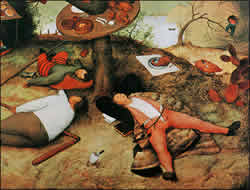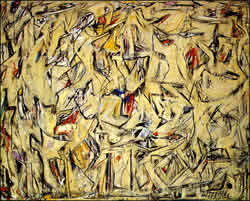bulimia, luilekkerland!
feb 26, 2004.
I only managed to catch two in this year's series of Présences
concerts, but on both occasions the liner notes mentioned works (partly)
inspired by the visual arts. First, on sunday february 8th, the concert
opened with a piece of Pascal
Zavaro's. "Three Studies for a Crucifixion", inspired by Francis
Bacon's tryptich
of the same title. The British painter always had a special relation
with Paris and France, and a strong presence and impact here (think
of Gilles
Deleuze writings), so it is sort of obvious for a Parisian composer
to become inspired by Bacon's work.
Like me, Zavaro must have seen the tryptich during the big Bacon retrospective
at the Centre Pompidou, between june and october 1996. The quote in the
evening's programme describing a first sight of the work is from Tate Gallery
director Rothenstein. Taken from the Pompidou retrospective's catalogue,
I presume.
"Why Rothenstein's? Why not a couple of words describing your own first
encounter with the painting?" was my initial thought. But I guess Zavaro
wanted to save the expression of his impressions for the music?
Much more information the liner notes did not provide. Only that the composer
wanted "faire des choses très formelles mais tombant en morceaux".
Still. In hindsight Zavaro's work was the liveliest and most interesting
of the evening (which further included a somewhat Berg-ish Concerto
for violoncelle by Philippe
Hersant (this year's 'compositeur vedette' of the festival), Edvard
Grieg's Fra Holbergs tid (Holbergsuiten) and Qsar Ghilâne,
le Palais des Djinns, a thoroughly boring - or badly performed, or
both - orchestral piece, with at times curiously erring percussion parts,
written by Jean-Louis Florentz, member
of the French Academie of Arts). Despite of a couple of too stereotyped
parts breathing a softish Mahlerian/'Death in Venice'-like melancholy, and
some other touches of melodrama, Zavaro's "Three Studies for a Crucifixion"
was set in interesting colours, with sudden displays of, well, yes: 'Baconian'
ruthlessness, an occasional quite subtle bitterness, and at times a mighty
good beat. Fierce. Powerful. It was very cinematographic, in a
way; sounded like there was some story to be told. Which I guess is where
it fails in its pretended correspondence to Bacon's tryptich. Which is where
any piece of music - or other type of text, for that matter - necessarily
fails would it strive for a rephrasing, a translation, of an image. In the
painting all of it is there at once, simultaneously. A
good painting is like thunder. It's a ba
- béng, bringing it all home at once. There
is no 'time' proceeding, there is no 'story' unfolding, or only something
very secondary at best. Of course Pascal Zavaro did not strive for such
a 'translation'. It were the whatever-it-was that made him name the piece
and the liner notes that suggested it. And as a result there was me
looking for it, hearing the music as if it were meant to be...
It wasn't, and so I didn't find what I was hearing for.
Time got in the way.
Instantly.
The second visually inspired composition was the very last piece of the festival, performed at the 'closing concert' on saturday, february 14: "Paysage avec ruines", by the vedette Philippe Hersant. The piece had been partly inspired, Hersant wrote in the accompanying notes, "by the very strange paintings of Monsu Desiderio [...] This name, Desiderio, actually concealed two painters from the Lorraine who emigrated to Naples at the beginning of the 17th century. One painted extraordinary architectural ruins, the other inserted little characters [...] into this apocalyptic framework".
 |
![VIncent Desiderio - Cockaigne [1993-2003] Desiderio's Cockaigne](http://www.harsmedia.com/Pics/SB/cockaigne.jpg) |
 |
Funny it was, to come across that name 'Desiderio' again... two weeks earlier
it had been also the name of a painter, third one ..., when I accidentally
hit upon an article
in the web-edition of the New York Times, opening big with a picture of
a table and art books unorderly spread across the floor around it, sea like,
with open pages, revealing their content: pictures of paintings, works of
art, that is. (Or how 'accidentally' was this? I had been attracted
to it, as I arrived at the article by clicking a thumbnail version of the
same picture somewhere on the downside of that day's NYT web's frontpage.)
It is a very powerful image. A veritable ba
- béng. First it hit me. Then I kept looking
at it, on and on and on.
At first I thought it was a photograph. But it is not. It is a painting by the American
'contemporary realist' painter Vincent Desiderio. It is a very big
painting. The oil on canvas measures 284.2 by 389.6 centimeters. It was
part of the artist's recent
exhibition in the New York Marlborough Galery. The piece is called Cockaigne,
like 'in the land of ...' (Luilekkerland, Schlaraffenland), and
- as was nicely pointed out by Mia Fineman in her
NYT article - modelled after two earlier well-known works of western
art: Pieter Bruegel the Elder's "The Land of Cockaigne" (oil on
panel, 1567) gave Desiderio's Cockaigne its name and its table.
The painting's structure, its 'abstract' composition, is taken from Willem
de Kooning's "Excavation" (oil on canvas, 1950).
It is a work of art that I would like very much to taste from nearby.
I was - of course - not the only one to be strucken by the appearance of
the painting's picture in the NYT.
"[T]he first thing that came into my mind was, I really want a poster
of that!" one blogger
wrote ... which, he observes, might just prove "the truth of Desiderio's
critique".
Critique?
"The targets in Bruegel's painting were gluttony and sloth; Mr. Desiderio's
version is a critique of what he calls "cultural bulimia" - our compulsive
consumption of images that only leaves us hungry for more," Mia Fineman
explained.
But that seems such a triviality. Obvious arty opening chit-chat. Cultural
Bulimia. CB. Carte Bancaire. Even if I might appreciate this critique,
or acknowledge it as being (part of) the artist's intention ... : it is
not the 'picture as a critique of cultural bulimia' that attracts me. It
is the picture.
So then what is it that fascinates me, and fascinated me at first
sight? Is it its obvious intellectuality? I think that one of the
reasons is its possible, but so very, very improbable configuration. Funny
enough I feel as if part of the ba - béng
caused by Desiderio's painting (for me) is the improbability of any scenario
(story, indeed) leading up to the depicted - at first sight pretty
realistic - scene.
But it is far from 'realist'.
The scene, what we see inside the frame, could have been created by humans only ... but then how could it have come about? Clearly there is no (longer?) any room left for a human presence. There is no place to sit at the table, where recently, or so it seems, people have been consuming. There's no place to stand, and no path to walk along. So there is no possible way someone could have just left the table, to exit the frame. Except by stepping on the books. But that could not possibly be done without badly damaging them. There are so many of them, and they do not look as if they've just been treaded upon. They appear to be in good shape, just openend up. So then, did all of the books, or at least a big part of them, landed there after the meal? Are we then in a room, a hall, whose walls were covered by bookcases, shelf after shelf filled with art books? And did the diner(s), after having finished his/her/their meal(s) take his/her/their chair(s) to the sides, left them near the book covered walls, or mounted upon them, and began taking books off the shelves, only to throw them on the floor around the table? But if they were carelessly throwing, then how on earth did they manage to produce this 'neat sea-like, covering' of the floor, giving the impression as if originating from an originally central pile, that then was carefully flattened and spread out? Or was this an empty room, in which it suddenly has started raining books? And was the 'table-after-dinner' carefully lowered after the rain, to be placed among the books?
None of these, of course. There surely is but one answer: there were no diners; nobody dined, and nobody left the dining table in order to step upon or throw about art books, nor was it lowered carefully from above. The art books did not come raining down, nor have been been thrown about, and nobody ate there in that room. Indeed, though the image suggests randomness, chaos and disorder, it actually is highly composed, very ordered and unnaturally symmetrical. This is not a realist image. It is a very abstract one, so much more like the De Kooning than it is Bruegel. And there was only this one human involved. He stayed outside of the frame, all the time. It was he that carefully posed each of the books, and turned up the right pages. With lots of care, lots of attention and lots of thought. It was he that draped the white cloth on the small dining table, and left the remnants of a meal there, as if it were an altar abandoned in mid mass.
He painted the picture.
[ Next related SB-entry: toc toc toc :: Earlier related SB-entry: meta music ]
[ modified - april 24th, 2005 ]
tags: Paris, Présences, Francis Bacon, Desiderio, bulimia, cockaigne
# .95.
del.icio.us | Digg it! | reddit | StumbleUpon